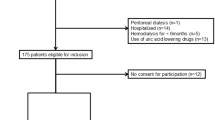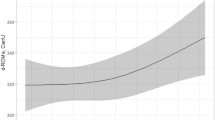Abstract
The increased oxidative stress in diabetes is known to contribute to the development of diabetes. We investigate whether serum 8-hydro-2′-deoxyguanosine (8-oxo-dG) is associated with diabetes at the time of first diagnosis and evaluate whether it can be used as a reliable biomarker for the oxidative stress in diabetes. The study was designed as a case control study with two groups: patient with diabetes and control. The diabetes group consisted of a total of 28 patients consulting the hospital for the first time and definitely diagnosed for diabetes, and the control group was composed of 65 healthy subjects. Serum 8-oxo-dG was measured by a competitive enzyme-linked immunosorbent assay (ELISA) kit, specially developed to minimize cross-reaction of 8-oxo-dG antibody with serum guanosine. The average serum 8-oxo-dG levels in patients with diabetes and controls were 0.72 ± 0.41 and 0.24 ± 0.14 ng/mL, respectively, statistically significant (p < 0.001). The 8-oxo-dG value was significantly higher in women with diabetes, compared with men with diabetes (p = 0.028). The sensitivity and the specificity of the 8-oxo-dG ELISA assay were 0.80 and 0.96, respectively, and the ROC value was 0.93. This study suggests that increased oxidative stress has an important role in the pathogenesis of diabetes. Serum 8-oxo-dG may be a useful clinical biomarker for the early diagnosis of stress-related diseases, e.g. diabetes and its management.


Similar content being viewed by others
References
Broedbaem K, Weimann A, Stovgaard ES, et al. Urinary 8-oxo-7,8-dihydro-2’-deoxyguanosine as a biomarker in type 2 diabetes. Free Radical Biol Med. 2011;51(8):1473–9.
Piconi L, Quagliaro L, Ceriello A. Oxidative stress in diabetes. Clin Chem Lab Med. 2003;41(9):1144–9.
Opara EC. Oxidative stress, micronutrients, diabetes mellitus and its complications. J R Soc Promot Health. 2002;122(1):28–34.
Nishikawa T, Edelstein D, Du XL, et al. Normalizing mitochondrial superoxide production blocks three pathways of hyperglycaemic damage. Nature. 2000;404(6779):787–90.
Loft S, Poulsen HE. Markers of oxidative damage to DNA: antioxidants and molecular damage. Methods Enzymol. 1999;300:166–84.
Dong QY, Cui Y, Chen L, et al. Urinary 8-hydroxydeoxyguanosine levels in diabetic retinopathy patients. Eur J Ophthalmol. 2008;18(1):94–8.
Xu GW, Yao QH, Weng QF, et al. Study of urinary 8-hydroxydeoxyguanosine as a biomarker of oxidative DNA damage in diabetic nephropathy patients. J Pharm Biomed Anal. 2004;36(1):101–4.
Ha H, Kim C, Son Y, et al. DNA damage in the kidneys of diabetic rats exhibiting microalbuminuria. Free Radical Biol Med. 1994;16(2):271–4.
Haghdoost S, Czene S, Naslund I, et al. Extracellular 8-oxo-dG as a sensitive parameter for oxidative stress in vivo and in vitro. Free Radical Res. 2005;39(2):153–62.
Wu LL, Chiou CC, Chang PY, et al. Urinary 8-OHdG: a marker of oxidative stress to DNA and a risk factor for cancer, atherosclerosis and diabetics. Clin Chim Acta. 2004;339(1–2):1–9.
Broedbaek K, Siersma V, Henriksen T, et al. Urinary markers of nucleic acid oxidation and long-term mortality of newly diagnosed type 2 diabetic patients. Diabetes Care. 2011;34(12):2594–6.
Sangsuwan T, Haghdoost S. The nucleotide pool, a target for low-dose gamma-ray-induced oxidative stress. Radiat Res. 2008;170(6):776–83.
Harms-Ringdahl M, Jenssen D, Haghdoost S. Tomato juice intake suppressed serum concentration of 8-oxodG after extensive physical activity. Nutr J. 2012;11:29.
Haghdoost S, Sjolander L, Czene S, et al. The nucleotide pool is a significant target for oxidative stress. Free Radic Biol Med. 2006;41(4):620–6.
Mascarenhas-Melo F, Marado D, Palavra F, et al. Diabetes abrogates sex differences and aggravates cardiometabolic risk in postmenopausal women. Cardiovasc Diabetol. 2013;12:61.
Hinokio Y, Suzuki S, Hirai M, et al. Urinary excretion of 8-oxo-7,8-dihydro-2′-deoxyguanosine as a predictor of the development of diabetic nephropathy. Diabetologia. 2002;45(6):877–82.
Bonnefont-Rousselot D. Glucose and reactive oxygen species. Curr Opin Clin Nutr Metab Care. 2002;5(5):561–8.
Evans JL, Goldfine ID, Maddux BA, et al. Oxidative stress and stress-activated signaling pathways: a unifying hypothesis of type 2 diabetes. Endocr Rev. 2002;23(5):599–622.
Maritim AC, Sanders RA, Watkins JB. Diabetes, oxidative stress, and antioxidants: a review. J Biochem Mol Toxicol. 2003;17(1):24–38.
Mohamed AK, Bierhaus A, Schiekofer S, et al. The role of oxidative stress and NF-kappaB activation in late diabetic complications. Biofactors. 1999;10(2–3):157–67.
Haghdoost S, Maruyama Y, Pecoits-Filho R, et al. Elevated serum 8-oxo-dG in hemodialysis patients: a marker of systemic inflammation? Antioxid Redox Signal. 2006;8(11–12):2169–73.
Nakabeppu Y. Molecular genetics and structural biology of human MutT homolog, MTH1. Mutat Res. 2001;477(1–2):59–70.
Boonla C, Wunsuwan R, Tungsanga K, et al. Urinary 8-hydroxydeoxyguanosine is elevated in patients with nephrolithiasis. Urol Res. 2007;35(4):185–91.
Kanauchi M, Nishioka H, Hashimoto T. Oxidative DNA damage and tubulointerstitial injury in diabetic nephropathy. Nephron. 2002;91(2):327–9.
Leinonen J, Lehtimaki T, Toyokuni S, et al. New biomarker evidence of oxidative DNA damage in patients with non-insulin-dependent diabetes mellitus. FEBS Lett. 1997;417(1):150–2.
Hinokio Y, Suzuki S, Hirai M, et al. Oxidative DNA damage in diabetes mellitus: its association with diabetic complications. Diabetologia. 1999;42(8):995–8.
ChiouCC CPY, Chan EC, et al. Urinary 8-hydroxydeoxyguanosine and its analogs as DNA marker of oxidative stress: development of an ELISA and measurement in both bladder and prostate cancers. Clin Chim Acta. 2003;334(1–2):87–94.
Al-Aubaidy HA, Jelinek HF. Oxidative DNA damage and obesity in type 2 diabetes mellitus. Eur J Endocrinol. 2011;164(6):899–904.
Topic A, Francuski D, Markovic B, et al. Gender-related reference intervals of urinary 8-oxo-7,8-dihydro-2’-deoxyguanosine determined by liquid chromatography-tandem mass spectrometry in Serbian population. Clin Biochem. 2013;46(4–5):321–6.
Acknowledgments
This work was supported by the Shanghai Committee of Science and Technology Development Funds for Basic Research under grant number 10JC1404800. Health Biomarker Sweden AB also supported this study.
Conflict of interest
MHR, SH and SS are owner of Health Biomarker Sweden. All other authors declare no conflict of interest.
Author information
Authors and Affiliations
Corresponding author
Additional information
Dr. Jiao Sun and Dr. Xudan Lou contribute to the work equally and should be regarded as co-first authors.
Rights and permissions
About this article
Cite this article
Sun, J., Lou, X., Wang, H. et al. Serum 8-hydroxy-2′-deoxyguanosine (8-oxo-dG) levels are elevated in diabetes patients. Int J Diabetes Dev Ctries 35, 368–373 (2015). https://doi.org/10.1007/s13410-015-0301-8
Received:
Accepted:
Published:
Issue Date:
DOI: https://doi.org/10.1007/s13410-015-0301-8




